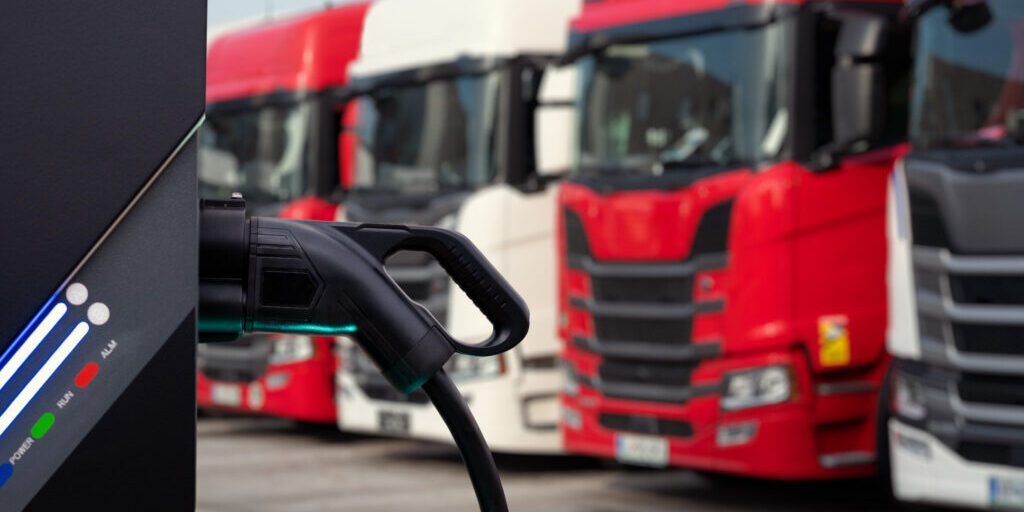Reducing Carbon Emissions from the Heavy-Duty Vehicles Sector in Europe

The European Green Deal’s Impact on HDVs
Heavy-duty vehicles (HDVs) contribute to roughly a quarter of CO2 emissions from road transport within the EU. Despite a temporary dip in 2020 due to the COVID-19 pandemic, emissions from this sector have risen annually since 2014, driven by a growing demand for freight transport. The European Green Deal seeks to achieve climate neutrality by 2050, necessitating large-scale changes within the transport sector, which accounts for around a quarter of EU greenhouse gas (GHG) emissions.
As a company dedicated to reducing the carbon footprint of supply chains, Think Carbon wants to see the investment in and development of technologies that help to minimise emissions from transport be treated as a top priority. By offering a predictive carbon calculator that utilises the latest in artificial intelligence technology, Think Carbon aims to empower businesses with the knowledge required to make environmentally conscious decisions when it comes to transport. As the transport sector continues to be a significant contributor of GHG emissions, Think Carbon’s tools can help businesses to better understand their impact on the environment and to make more sustainable choices.
Innovative Technologies for a Greener Future
HDVs include trucks weighing over 3.5 tonnes as well as buses and coaches with more than eight seats. Trucks are the primary contributor to HDV emissions, accounting for approximately 85% of the total. The EU has been introducing a number of policies aimed at tackling the CO2 emissions from HDVs, including The Effort Sharing Legislation, the EU Emissions Trading System, and the Energy Efficiency Directive. EU Member States have also been taking steps to reduce transport emissions, such as efforts to construct electric road systems, implement CO2 components in truck tolls, improve rail infrastructure, and promote zero-emission urban transport.
A European Environment Agency (EEA) report conducted a decomposition analysis for truck emissions in the EU Member States and identified several factors driving emission trends. These factors included freight transport demand, the share of trucks in inland freight transport, energy efficiency of trucks, the share of fossil fuels in truck fuel consumption, and the carbon intensity of fossil fuels consumed by trucks.
To reverse the current trend of increasing road transport emissions, a combination of ‘avoid’, ‘shift’, and ‘improve’ strategies is necessary. ‘Avoid’ strategies focus on reducing the number and length of trips; ‘shift’ strategies aim to move transport activity to more efficient modes, and ‘improve’ strategies involve enhancing vehicle and fuel technologies for greater efficiency.
In the coming decades, more zero-emission vehicles will hit the roads, and existing vehicles will need to become more carbon and energy-efficient. A faster and more comprehensive transition will require a shift to transport modes with lower emissions. The EU will also need to target transport demand directly or via incentives in other areas, such as local production and circular economy initiatives.
One way to reduce GHG emissions from transport is to switch to haulage options that generate fewer emissions. For freight transport, road freight emits significantly more GHG emissions than rail or ship transport. Therefore, using rail and ship haulage options as much as possible, while minimising the use of road haulage, is one of the most powerful ways of reducing the emissions produced from freight transport. For passenger transport, cars and aviation have the highest emissions per passenger-kilometre, while public transport modes, such as rail, buses, and coaches, are more efficient. People shifting from cars and planes to buses and trains would be another highly effective means of reducing GHG emissions from HDV transport.
The energy efficiency of road freight plays a significant role in emissions trends, and improvements in vehicle efficiency are likely to play a greater role in the future. The EU aims to incentivise manufacturers to ensure that new vehicles sold in the EU become more efficient. Regulations mandating targets for the CO2 emission performance of new passenger cars and vans have been in place since 2009 and 2011, respectively; the EU has introduced CO2 emission standards for new HDVs to complement these regulations.
Embracing Alternative Fuels and Infrastructure
Currently, most trucks are diesel-powered, but to reduce emissions and meet targets, trucks will increasingly be powered by alternative means in the future, such as electric batteries or hydrogen fuel cells. Countries can facilitate the uptake of such vehicles by providing refuelling and charging infrastructure, as well as incentives for manufacturers and fleet operators to adopt these technologies.
Additionally, greater emphasis on research and development of innovative technologies, such as energy-efficient electric drivetrains, lightweight materials, and aerodynamic designs, can help to further reduce emissions from HDVs. Collaboration between the automotive industry, policymakers, and academia will be crucial to accelerating the development and adoption of these technologies.
Another approach to reducing GHG emissions from HDVs is encouraging the adoption of alternative fuels with lower carbon intensity. For example, biofuels, synthetic fuels, and renewable natural gas can help reduce the carbon footprint of road transport – provided that they are produced in a sustainable manner. Policies should be put in place to ensure the sustainability of these alternative fuels and to promote their use in the transport sector.
Efficiency and Sustainability in Road Transport Systems
Lastly, promoting more efficient use of the transport network can contribute to reducing emissions. Measures such as platooning, where connected trucks drive in a closely spaced convoy to reduce air resistance and improve fuel efficiency, and intelligent transport systems can optimise traffic flow and contribute to a more efficient and sustainable road transport system.
In conclusion, achieving the European Green Deal’s goal of climate neutrality by 2050 requires a comprehensive and multi-faceted approach to reducing greenhouse gas emissions from the heavy-duty vehicle sector. This includes shifting to more efficient transport modes, improving vehicle and fuel technologies, promoting the use of alternative fuels, and optimising the transport network. Think Carbon is dedicated to supporting these efforts by providing businesses with the tools and knowledge needed to make more sustainable choices in their supply chains and transport operations.